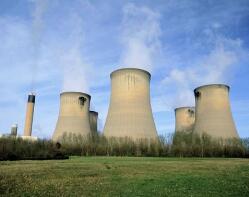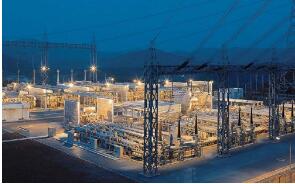Nuclear energy is also known as atomic energy. The energy released when the nucleus in the nucleus is redistributed. Nuclear energy can be divided into three categories:
(1) Fission energy, the energy released by the nucleus of heavy elements (such as uranium, thorium, etc.) when it splits;
(2) Fusion energy, the energy released by the polymerization of light elements (æ°˜ and æ°š) nuclei;
(3) Radiation energy emitted when the atomic nucleus decays.
The difference between nuclear energy and chemical energy is that chemical energy is obtained by the exchange of electrons between atoms in a chemical reaction. For example, when coal or petroleum is burned, only a few electron volts can be released during the oxidation of each carbon or hydrogen atom, and nuclear energy is redistributed by the nucleus (neutron or proton) in the nucleus to obtain energy. It is surprising.
For example, when each uranium atom is fission, 200 million electron volts of energy can be released, so the energy released when 1 kg of uranium is fission is equivalent to 2,500 tons of standard coal. An equal amount of fusion fuel releases 4 to 5 times more energy than fission energy during fusion. Nowadays, people have used nuclear fission energy to generate electricity and heat, and are also studying controlled nuclear fusion, trying to develop and utilize nuclear fusion energy. The use of radioactivity is also common. For example, a radioactive battery uses the energy released by é’š-238 during decay to generate electricity.

Advantages of nuclear energy:
1. Nuclear power generation does not emit a huge amount of pollutants into the atmosphere like fossil fuel power generation, so nuclear power generation will not cause air pollution.
2. Nuclear power generation does not produce carbon dioxide that aggravates the global warming effect.
3. Uranium fuel used in nuclear power generation has no other use than power generation.
4. The energy density of nuclear fuel is several million times higher than that of fossil fuels. Therefore, the fuel used in nuclear power plants is small in size and convenient for transportation and storage. A 1000 megawatt nuclear power plant requires only 30 metric tons of uranium fuel per year. The plane can be completed by a voyage.
5. Among the costs of nuclear power generation, the proportion of fuel costs is relatively low, and the cost of nuclear power generation is less susceptible to the international economic situation, so the cost of power generation is more stable than other power generation methods.
Disadvantages of nuclear energy:
1. Nuclear power plants produce high-level and low-level radioactive waste, or used nuclear fuel. Although they are small in size, they must be treated with caution because of their radiation, and they face considerable political troubles.
2. The nuclear power plant has low thermal efficiency, so it emits more waste heat into the environment than the general fossil fuel power plant, so the thermal pollution of the nuclear power plant is more serious.
3. The investment cost of nuclear power plants is too large, and the financial risks of power companies are high.
4. Nuclear power plants are less suitable for peak-loading and off-peak operation.
5. The construction of nuclear power plants is more likely to trigger political differences.
6. There are a large amount of radioactive materials in the reactor of a nuclear power plant. If it is released into the external environment during an accident, it will cause harm to the ecology and the public.

Primary energy that has been produced on a large scale and widely used is also called traditional energy. Such as coal, oil, natural gas and water, it is the main source of energy for social progress and civilization. When discussing energy issues, it mainly refers to conventional energy sources. New energy is the energy that is systematically developed and utilized on the basis of new technologies, such as solar energy, wind energy, ocean energy, geothermal energy, etc. Compared with conventional energy sources, new energy production is small in scale and narrow in use.
The division of conventional energy and new energy is relative. Take nuclear fission energy as an example. When it was used in the early 1950s to produce electricity and use it as a power source, it was considered a new energy source. By the 1980s, many countries in the world had classified it as a regular energy source. The history of solar energy and wind energy utilization is many years earlier than nuclear fission energy. Because of the need to systematically research and develop to improve utilization efficiency and expand the scope of use, they are still included in new energy sources.

Coal, oil, natural gas, hydropower and nuclear power are collectively referred to as traditional energy sources. But in the first industrial revolution, coal replaced the traditional energy of firewood as a new energy source. Therefore, when a new energy source is applied on a large scale and has been long enough, it becomes a traditional energy source.
At present, the three sources of oil, natural gas and coal account for more than 80% of the global energy share. These three kinds of energy are also called "fossil energy" because their causes are due to the evolution of plants or animals in ancient times. These existing energy sources can be widely used to become "traditional".
The advantages of traditional energy:
1. It has a relatively high energy density. The energy density can be calculated according to the energy produced per unit weight or unit volume. According to the mass, the energy density of natural gas is the highest, followed by oil, and coal again. However, if calculated according to the volume, the oil is the highest, the coal is second, and the natural gas is second. Therefore, LNG is used to liquefy natural gas, in which case natural gas can maintain the highest energy density.
2. They are easy to mine, transport and store. Whether it is solid coal, liquid oil or gaseous natural gas, it can be conveniently stored and transported. In fact, the exploitation, storage and transportation of these three traditional energy sources are very complicated, and humans have spent countless years in order to transport and store these energy sources. The funds have established a huge storage and transportation system. Taking coal as an example, coal mines, coal-fired power plants (related boilers, steam turbines, generators, desulfurization, cooling, etc.), for the transportation of railways, highways and huge cargo tools, these systems for coal to generate electricity It has become a huge industry, even huge enough to be difficult to remove. Oil refining is even more complicated.
3, that is, they once had a large reserve, the cost is low enough, and even once considered to be inexhaustible. These three reasons not only make these energy sources widely used in the first and second industrial revolutions, but also make them occupy a very important share of the human economy and society for a long time to come. Of course, the low cost mentioned here naturally does not include the impact of resource destruction and environmental damage on people's health.
Disadvantages of traditional energy
However, with the increasing demand for energy in human life, industrial and commercial activities, the exploitation of traditional energy sources is becoming more and more difficult, and the easy-exploiting coal mines and oil fields are continuously exhausted, and limited reserves are now beginning to become visible. The energy reserves are only a few decades old. People began to worry about the reserves of fossil energy. It is recognized that the reserves of these fossil energy sources are not unlimited. Even with sufficient reserves, the cost of mining these energy sources will be higher and higher before they are exhausted. This is the so-called energy depletion problem. With the recent development of emerging economies, energy consumption is growing. What's more, when energy is really exhausted, then the impact on society is not a question of cost, but a question of whether human economy and society can continue.
At the same time, these energy sources emit carbon dioxide when they are used, which not only causes climate warming, but also makes it difficult to avoid pollution such as dust and acid rain. Especially this year, after the rise of many developing countries, energy consumption has risen sharply. The situation of pollution is no longer as far away as it used to be, but it has affected everyone's life and even life. Although hydropower and nuclear power do not have carbon emissions from nuclear dust under normal conditions, they can be called clean energy. However, the requirements for natural conditions and the ecological impact of hydropower stations are actually very limited, especially for large hydropower stations. Nuclear power fuel uranium ore has more limited reserves, and since the Chernobyl and Fukushima nuclear accidents, it has been recognized that nuclear pollution in the event of an accident is very difficult to predict and control.
The greenhouse effect and extreme climate change caused by carbon dioxide emissions make human ecology more and more fragile, and smog and acid rain directly threaten human survival. All people realize that if the energy system does not change, acid rain and smog will become more and more frequent, and the earth will not only become uninhabitable due to pollution, but also have a disastrous impact on human beings.
If energy depletion and environmental pollution are taken into account, the cost of traditional energy will be higher than the cost of photovoltaics. Then the cost of medical care paid by governments for pollution is calculated, and the cost is even more terrible.
Therefore, people turn their attention to new, renewable, and clean energy, not to pursue fashion, nor to pretend to be sacred, but to make choices for their own survival.

Our company specializes in the production and sales of all kinds of terminals, copper terminals, nose wire ears, cold pressed terminals, copper joints, but also according to customer requirements for customization and production, our raw materials are produced and sold by ourselves, we have their own raw materials processing plant, high purity T2 copper, quality and quantity, come to me to order it!
Copper Connecting Terminals,Cable Lugs Insulated Cord End Terminals,Pvc Insulated Cord End Terminal,Cable Connector Insulated Cord End Terminal
Taixing Longyi Terminals Co.,Ltd. , https://www.longyiterminals.com